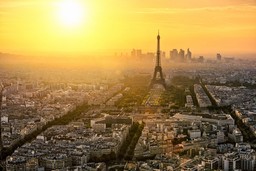13. Europe
Contents
13.1 What is Europe?
13.2 The borders of Europe
The name Europe is thought to be derive from the name of princess Europa in Greek mythology. Other theories of the name's origin have also been presented. The European continent is part of the larger continent of Eurasia. The European continent is sometimes also called the European peninsula.
A map of the world. Our planet has seven continents, of which Europe is the second smallest.
Europe is separated from other continents by various geographical features. These features include - from east to west - the Ural Mountains, the Ural River, the Caspian Sea, the Caucasus, the Black Sea, the Strait of Bosphorus, the Mediterranean Sea, the Atlantic Ocean and the Arcitc Ocean.
Europe contains numerous islands: the most notable of these include Great Britain, Ireland, Iceland, the Norwegian Svalbard and the Russian Novaja Zemla. Some of the most significant islands of the Mediterranean region include Sicily, Sardinia and Corsica. The Mediterranean also contains a number of popular tourist destinations, such as the Greek island of Crete and the Spanish Balearic Islands.
The borders between European nations have changed innumerable times during the continent's history, and they have often been the sources of conflict, including the the two world wars. Nowadays, the borders between nations have been internationally acknowledged, although a couple of exceptions exist. Minority groups of some European regions, such as the Spanish Catalan and Basque people, have struggled to gain autonomy and independence, but so far this struggle has not resulted in any changes to the map of Europe.
 The Mediterranean island of Malta is located on the southernmost border of Europe.
The Mediterranean island of Malta is located on the southernmost border of Europe.
13.3 The regions of Europe
Europe is often divided into five main regions: Northern Europe, Southern Europe, Western Europe, Central Europe and Eastern Europe. This classification often follows national borders. However, Europe can also be divided into regions in other ways, some of which do not follow state borders. The map below displays the main European regions both following national borders and following cultural proximities.

13.4 European nations
13.5 European landscapes
 The natural conditions of the European continent are well suited for human inhabitation. This is due to the fact that both the European soil types and climatic conditions, such as temperature and precipitation, make varied and efficient agriculture possible.
The natural conditions of the European continent are well suited for human inhabitation. This is due to the fact that both the European soil types and climatic conditions, such as temperature and precipitation, make varied and efficient agriculture possible.
The climatic conditions of the European continent can vary significantly between its border regions. You can easily imagine the differences between the climates of Lapland, Athens, Moscow and London. This climatic variation is the result of the region's distance from the equator and the Atlantic Ocean. The warming effect of the Gulf stream also influences the climate of Western and Northern Europe.
Approximately 70 % of the European population lives in high-density urban areas. This means that the characteristic European landscape is a cultural landscape, where the results of human activity can be seen in the form of traffic routes, fields, buildings, and industry. The most densely populated areas include shore regions and river sides. The most densely inhabited European nations include Malta, the Netherlands and Belgium. Europe also includes some vast, sparsely populated areas. Such areas include the northern island nation of Iceland and various mountainous regions. Their natural landscapes are well-known for their beauty.
13.6 Gallery: Where are we?
13.7 The European Union
The European Union or the EU is a political and economic union of 27 nations. It has many charasteristics that suggest that it is like a nation in itself.
The official currency of the European Union is used by 19 of its member states. The euro was officially implemented in 2002. The European Union also has its own flag. It consists of 12 stars on a blue background, which symbolizes the unity, co-operation, and togetherness of the European nations.
You have most probably heard Ludwig van Beethoven's composition "Ode to Joy", but you might not have known that it is the official anthem of the European Union. It functions as a "national anthem" of the EU.
![]() Listen to the anthem on the official EU website
Listen to the anthem on the official EU website
The member states of the European Union share a common legislation and government. However, each of its member states also has its own legislation and government. The capital city of the EU is the Belgian capital of Brussels, but other important govermental offices are situated elsewhere, for example in Luxembourg. The official day of the European Union is the 9th of May. It symbolizes the peace and unity between European nations. "United in Diversity" is the motto of the European Union.
The EU member states also have their own passports. Border controls are lax on the borders between member states, but stricter on the outer borders of the union.

The official currency of the EU is the euro.
- Official currency: the euro
- Flag : 12 yellow stars in a circle, on a blue background
- Surface area: over 4 million square kilometers
- Population: 450 million (if it was a nation, it would be the 3rd largest in terms of population)
- Nations: 27
- Anthem: Ode to Joy
- Founded: 1993
- Europe Day: 9th of May
Summary
- Europe is one of the planet's seven continents.
- Although Europe is a relatively small continent, it contains a large number of nations, languages and ethnic groups.
- 27 member states comprise the European Union, which is a political and economical union with its own legislation, government and currency.


















